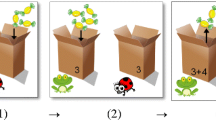Abstract
In this article we formulate and analyse some of the obstacles to understanding the notion of a variable, and the use and meaning of algebraic notation, and report empirical evidence to support the hypothesis that an approach using the computer will be more successful in overcoming these obstacles. The computer approach is formulated within a wider framework ofversatile thinking in which global, holistic processing complements local, sequential processing. This is done through a combination of programming in BASIC, physical activities which simulate computer storage and manipulation of variables, and specific software which evaluates expressions in standard mathematical notation. The software is designed to enable the user to explore examples and non-examples of a concept, in this case equivalent and non-equivalent expressions. We call such a piece of software ageneric organizer because if offers examples and non-examples which may be seen not just in specific terms, but as typical, or generic, examples of the algebraic processes, assisting the pupil in the difficult task of abstracting the more general concept which they represent. Empirical evidence from several related studies shows that such an approach significantly improves the understanding of higher order concepts in algebra, and that any initial loss in manipulative facility through lack of practice is more than made up at a later stage.
Similar content being viewed by others
References
BogenJ. E.: 1969, ‘The other side of the brain: 2. An appositional mind’,Bulletin of the Los-Angeles Neurological Society 34, 135–162.
BrumbyM. N.: 1982, ‘Consistent differences in cognitive styles shown for qualitative biological problem-solving’,British Journal of Educational Psychology 52, 244–257.
Descartes, R.: 1628,Regulae ad Directionem Ingenii (Published posthumously and also translated into English as ‘Rules for the direction of the mind’, in E. S. Haldane and G. R. T. Ross (eds.),The Philosophical Works of Descartes, 1934).
GardinerA.: 1988, ‘Will computers really count?’,Micromath 4(1), 31–32.
GazzanigaM. S.: 1974, ‘Cerebral dominance viewed as a decision system’, in S. J.Dimond and J. G.Beaumont (eds.),Hemisphere Function in the Human Brain, Elek Science, London, pp. 367–382.
GazzanigaM. S.: 1985,The Social Brain, Basic Books, New York.
HeidM. K.: 1988, ‘Resequencing skills and concepts in applied calculus using the computer as a tool’,Journal of Research in Mathematics Education 19(1), 3–25.
HerscovicsN. and KieranC.: 1980, ‘Constructing meaning for the concept of equation’,Mathematics Teacher 73, 572–580.
Kieran, C.: 1981, ‘Pre-algebraic notions among 12 and 13 year olds’,Proceedings of PME 5, Grenoble, pp. 158–164.
KrutetskiiV. A.: 1976,The Psychology of Mathematical Abilities in Schoolchildren (translated from the Russian by J. Teller), University of Chicago Press, Chicago.
Küchemann, D. E.: 1981, ‘Algebra’, in K. M. Hart (ed.),Children's Understanding of Mathematics: 11–16, John Murray, pp. 102–119.
Leitzel, J. R. and Demana, F.: 1988, ‘Establishing fundamental concepts in algebra through numerical problem-solving,’ in A. F. Coxford (ed.),The Ideas of Algebra K-12, NCTM 1988 Year Book, pp. 61–68, Reston, VA.
MatzM.: 1980, ‘Towards a computational theory of algebraic competence’,Journal of Mathematical Behaviour 3(1), 93–166.
PoincaréH.: 1903,La Science et l'hypothèse, included inThe Foundations of Science (translated by Halsted G. B., 1913), The Science Press, New York.
PopperK. R. and EcclesJ. C.: 1977,The Self and Its Brain, Springer, Berlin.
RosnickP. and ClementJ.: 1980, ‘Learning without understanding: The effect of tutorial strategies on algebra misconceptions’,Journal of Mathematical Behaviour 3(1), 3–27.
SeamonJ. G.: 1974, ‘Coding and retrieval processes and the hemispheres of the brain’, in S. J.Dimond and J. G.Beaumont (eds.),Hemisphere Function in the Human Brain, Elek Science, London, pp. 184–203.
SperryR. W., GazzanigaM. S. and BogenJ. E.: 1969, ‘Interhemispheric relationships: The neocortical commissures: Syndromes of hemispheric deconnection’, in P. J.Vinken and G. W.Bruyn (eds.),Handbook of Clinical Neurology, Vol. 4, North Holland Publishing Co., Amsterdam.
SkempR. R.: 1976, ‘Relational understanding and instrumental understanding’,Mathematics Teaching 77, 20–26.
SkempR. R.: 1979,Intelligence, Learning and Action, Wiley, Chichester.
Tall, D. O.: 1986,Building and Testing a Cognitive Approach to the Calculus Using Interactive Computer Graphics, Ph.D. thesis, University of Warwick.
Tall, D. O.: Concept images, generic organizers, computers and curriculum change’,For the Learning of Mathematics 9(3), 37–42.
Thomas, M. O. J.: 1985,The Effects of BASIC Computer Programming on the Understanding of the Use of Letters as Variables in Algebra, unpublished M.Sc. thesis, University of Warwick.
Thomas, M. O. J.: 1988,A Conceptual Approach to the Early Learning of Algebra Using a Computer, unpublished Ph.D. thesis, University of Warwick.
Thomas, M. O. J. and Tall, D. O.: 1986, ‘The value of the computer in learning algebra concepts’,Proceedings of the 10th Conference of PME, London.
Thomas, M. O. J. and Tall, D. O.: 1988, ‘Longer-term conceptual benefits from using a computer in algebra teaching’,Proceedings of the 12th Conference of PME, Veszprem, Hungary.
ThomasM. O. J. and TallD. O.: 1989a, ‘Dynamic algebra’, inSecondary Mathematics with Micros, Mathematical Association, Leicester, U.K.
Thomas, M. O. J. and Tall, D. O.: 1989b, ‘Verbal evidence for versatile understanding of variables in a computer environment’,Proceedings of the 13th Conference of PME, Paris.
Wagner, S.: 1977,Conservation of Equation, Conservation of Function and Their Relationship to Formal Operational Thinking, unpublished doctoral dissertation, New York University.
WagnerS.: 1981, ‘Conservation of equation and function under transformations of variable’,Journal for Research in Mathematics Education 12, 107–118.
Wagner, S., Rachlin, S. L. and Jensen, R. J.: 1984,Algebra Learning Project-Final Report, Department of Mathematics Education, University of Georgia.
Author information
Authors and Affiliations
Rights and permissions
About this article
Cite this article
Tall, D., Thomas, M. Encouraging versatile thinking in algebra using the computer. Educ Stud Math 22, 125–147 (1991). https://doi.org/10.1007/BF00555720
Issue Date:
DOI: https://doi.org/10.1007/BF00555720




